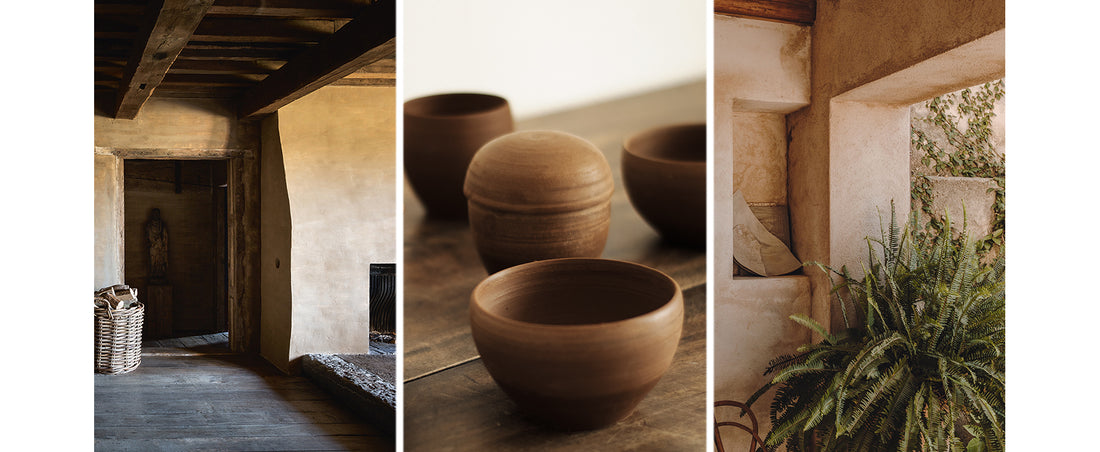
INI CERAMIQUE’s Definition Of Wabi Sabi - Studio Diary #2
Inhee MaSHARE
INI CERAMIQUE’s Definition Of Wabi Sabi - Studio Diary #2
. Today, I will humbly try to share with you my definition of wabi sabi and how it can inspire me throughout the whole creative process.
Originally from Japan, the wabi sabi concept can be seen as the art of imperfection, or at least as the acceptance of imperfection. Centered around nature and derived from the Buddhist philosophy, American artist and writer Leonard Koren described this aesthetic as based on the appreciation of a beauty that is ‘imperfect, impermanent and incomplete’.
Wabi sabi also puts the concept of time in the core of its principles. If wabi means simplicity and beauty in a modest form, sabi expresses the natural wear caused by time. Various key ideas come out of these elements, such as asymmetry, roughness, intimacy and the appreciation of both natural objects and the forces of nature.

As I mentioned before in what inspires me, I want to question the dialogue between craftsmanship, art and nature. I like to play with the functionality of the object and its materialization, wether in terms of texture of form. This is why for instance I prefer a chamotte clay for its natural raw texture. It reminds me of the rocks or stones you can find when you go for a walk in the woods.
Nothing is that straight, that smooth, that white or that black. Handmade craftsmanship forces you to accept this reality and it is up to us to embrace the beauty that comes out of it. There is a subtle imbalance surrounding us and maybe wabi sabi can be considered as a learning, to discover interest, fascination and beauty in the most basic natural, and imperfect indeed, objects.

The wabi sabi philosophy crossed the borders and is now more and more appreciated everywhere. When I was a teenager, I was really attracted by the work of a Korean contemporary artist named Lee Ufan. I loved (and still do) the purity of his installations and the strength of his propositions. I later realized one can consider his Art as wabi sabi inspired.
Wabi sabi is very present in architecture too. Japanese architect Architect Tadao Ando defines it as ‘an art of finding aesthetics in the forgotten realm and accepting the natural cycle of growth and decay’. In a way, we can say it is what we call « le charme de l’ancien » in French, ‘the charm of yesteryear’ and it is very popular too in interior design.

I don’t know if I would say my design are part of the wabi sabi movement. I try not to overthink my design process to be honest but undoubtedly I share the same considerations and like to question beauty around similar thoughts. If we can perceive happiness and peace in imperfections, it should make us relax and enjoy our precious time.


Wabi sabi also puts the concept of time in the core of its principles. If wabi means simplicity and beauty in a modest form, sabi expresses the natural wear caused by time. Various key ideas come out of these elements, such as asymmetry, roughness, intimacy and the appreciation of both natural objects and the forces of nature.

As I mentioned before in what inspires me, I want to question the dialogue between craftsmanship, art and nature. I like to play with the functionality of the object and its materialization, wether in terms of texture of form. This is why for instance I prefer a chamotte clay for its natural raw texture. It reminds me of the rocks or stones you can find when you go for a walk in the woods.
Nothing is that straight, that smooth, that white or that black. Handmade craftsmanship forces you to accept this reality and it is up to us to embrace the beauty that comes out of it. There is a subtle imbalance surrounding us and maybe wabi sabi can be considered as a learning, to discover interest, fascination and beauty in the most basic natural, and imperfect indeed, objects.

The wabi sabi philosophy crossed the borders and is now more and more appreciated everywhere. When I was a teenager, I was really attracted by the work of a Korean contemporary artist named Lee Ufan. I loved (and still do) the purity of his installations and the strength of his propositions. I later realized one can consider his Art as wabi sabi inspired.
Wabi sabi is very present in architecture too. Japanese architect Architect Tadao Ando defines it as ‘an art of finding aesthetics in the forgotten realm and accepting the natural cycle of growth and decay’. In a way, we can say it is what we call « le charme de l’ancien » in French, ‘the charm of yesteryear’ and it is very popular too in interior design.

I don’t know if I would say my design are part of the wabi sabi movement. I try not to overthink my design process to be honest but undoubtedly I share the same considerations and like to question beauty around similar thoughts. If we can perceive happiness and peace in imperfections, it should make us relax and enjoy our precious time.

